Business and the Business Environment - Unilever Assignment
VerifiedAdded on 2021/02/19
|13
|3954
|65
AI Summary
Contribute Materials
Your contribution can guide someone’s learning journey. Share your
documents today.
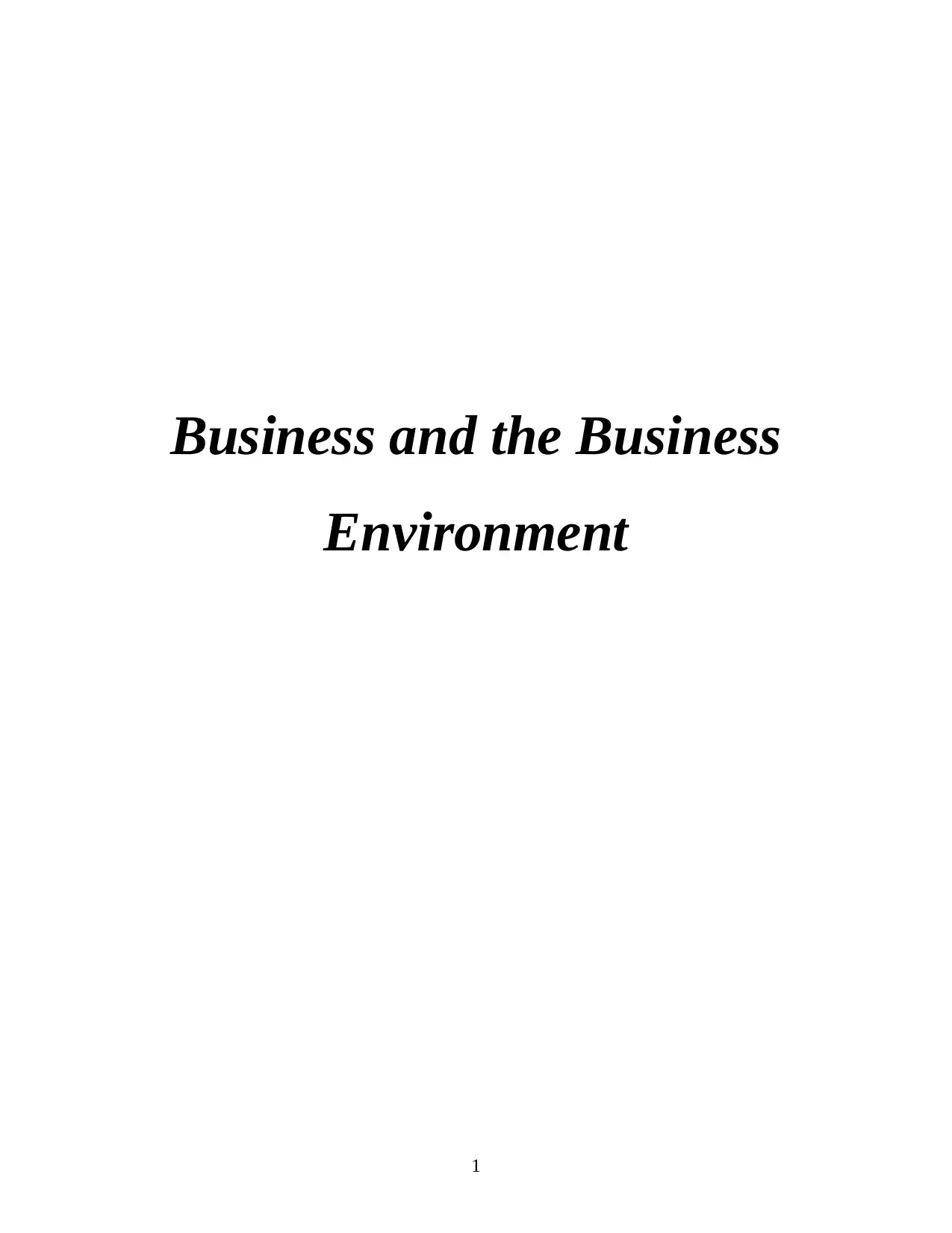
Business and the Business
Environment
1
Environment
1
Secure Best Marks with AI Grader
Need help grading? Try our AI Grader for instant feedback on your assignments.
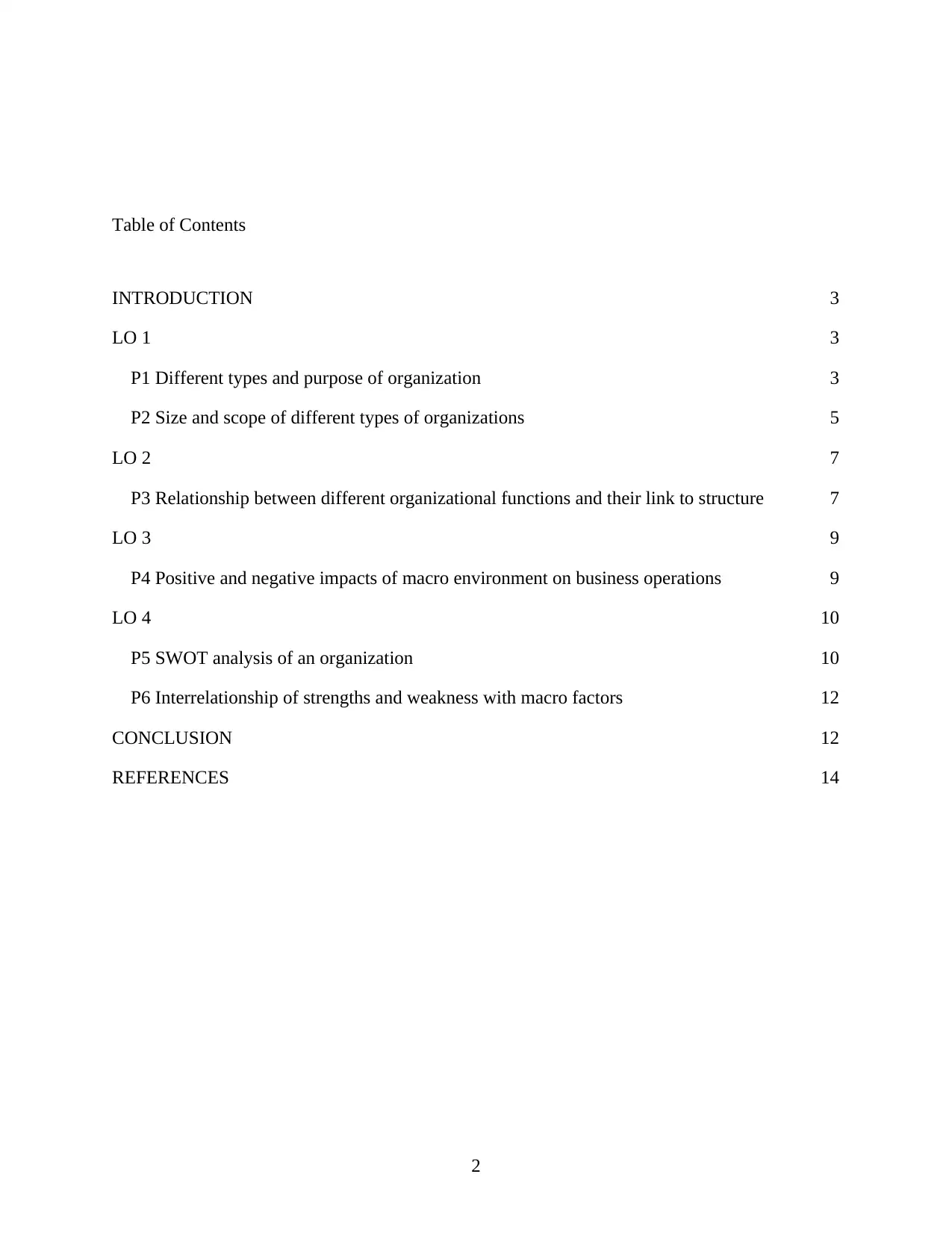
Table of Contents
INTRODUCTION 3
LO 1 3
P1 Different types and purpose of organization 3
P2 Size and scope of different types of organizations 5
LO 2 7
P3 Relationship between different organizational functions and their link to structure 7
LO 3 9
P4 Positive and negative impacts of macro environment on business operations 9
LO 4 10
P5 SWOT analysis of an organization 10
P6 Interrelationship of strengths and weakness with macro factors 12
CONCLUSION 12
REFERENCES 14
2
INTRODUCTION 3
LO 1 3
P1 Different types and purpose of organization 3
P2 Size and scope of different types of organizations 5
LO 2 7
P3 Relationship between different organizational functions and their link to structure 7
LO 3 9
P4 Positive and negative impacts of macro environment on business operations 9
LO 4 10
P5 SWOT analysis of an organization 10
P6 Interrelationship of strengths and weakness with macro factors 12
CONCLUSION 12
REFERENCES 14
2
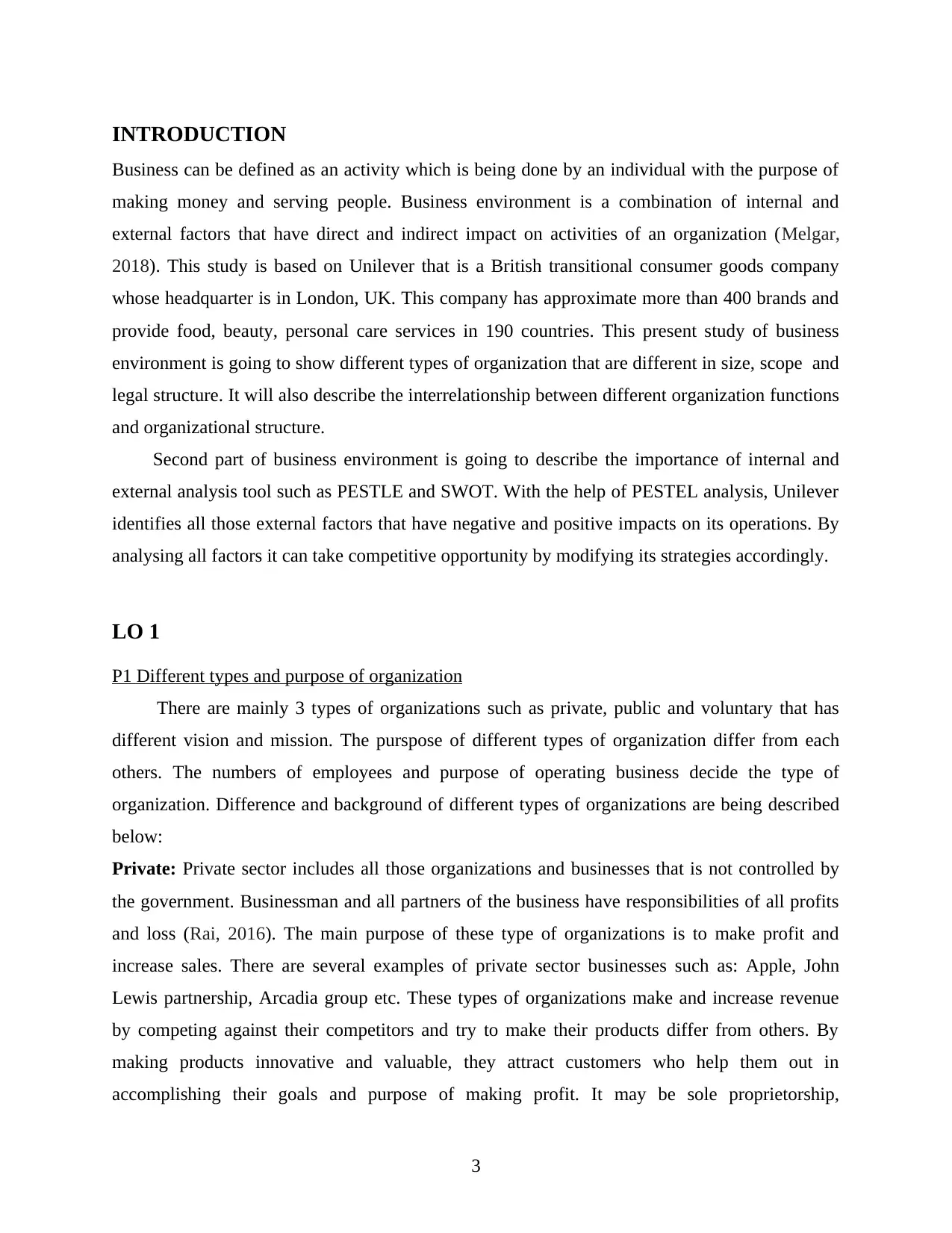
INTRODUCTION
Business can be defined as an activity which is being done by an individual with the purpose of
making money and serving people. Business environment is a combination of internal and
external factors that have direct and indirect impact on activities of an organization (Melgar,
2018). This study is based on Unilever that is a British transitional consumer goods company
whose headquarter is in London, UK. This company has approximate more than 400 brands and
provide food, beauty, personal care services in 190 countries. This present study of business
environment is going to show different types of organization that are different in size, scope and
legal structure. It will also describe the interrelationship between different organization functions
and organizational structure.
Second part of business environment is going to describe the importance of internal and
external analysis tool such as PESTLE and SWOT. With the help of PESTEL analysis, Unilever
identifies all those external factors that have negative and positive impacts on its operations. By
analysing all factors it can take competitive opportunity by modifying its strategies accordingly.
LO 1
P1 Different types and purpose of organization
There are mainly 3 types of organizations such as private, public and voluntary that has
different vision and mission. The purspose of different types of organization differ from each
others. The numbers of employees and purpose of operating business decide the type of
organization. Difference and background of different types of organizations are being described
below:
Private: Private sector includes all those organizations and businesses that is not controlled by
the government. Businessman and all partners of the business have responsibilities of all profits
and loss (Rai, 2016). The main purpose of these type of organizations is to make profit and
increase sales. There are several examples of private sector businesses such as: Apple, John
Lewis partnership, Arcadia group etc. These types of organizations make and increase revenue
by competing against their competitors and try to make their products differ from others. By
making products innovative and valuable, they attract customers who help them out in
accomplishing their goals and purpose of making profit. It may be sole proprietorship,
3
Business can be defined as an activity which is being done by an individual with the purpose of
making money and serving people. Business environment is a combination of internal and
external factors that have direct and indirect impact on activities of an organization (Melgar,
2018). This study is based on Unilever that is a British transitional consumer goods company
whose headquarter is in London, UK. This company has approximate more than 400 brands and
provide food, beauty, personal care services in 190 countries. This present study of business
environment is going to show different types of organization that are different in size, scope and
legal structure. It will also describe the interrelationship between different organization functions
and organizational structure.
Second part of business environment is going to describe the importance of internal and
external analysis tool such as PESTLE and SWOT. With the help of PESTEL analysis, Unilever
identifies all those external factors that have negative and positive impacts on its operations. By
analysing all factors it can take competitive opportunity by modifying its strategies accordingly.
LO 1
P1 Different types and purpose of organization
There are mainly 3 types of organizations such as private, public and voluntary that has
different vision and mission. The purspose of different types of organization differ from each
others. The numbers of employees and purpose of operating business decide the type of
organization. Difference and background of different types of organizations are being described
below:
Private: Private sector includes all those organizations and businesses that is not controlled by
the government. Businessman and all partners of the business have responsibilities of all profits
and loss (Rai, 2016). The main purpose of these type of organizations is to make profit and
increase sales. There are several examples of private sector businesses such as: Apple, John
Lewis partnership, Arcadia group etc. These types of organizations make and increase revenue
by competing against their competitors and try to make their products differ from others. By
making products innovative and valuable, they attract customers who help them out in
accomplishing their goals and purpose of making profit. It may be sole proprietorship,
3
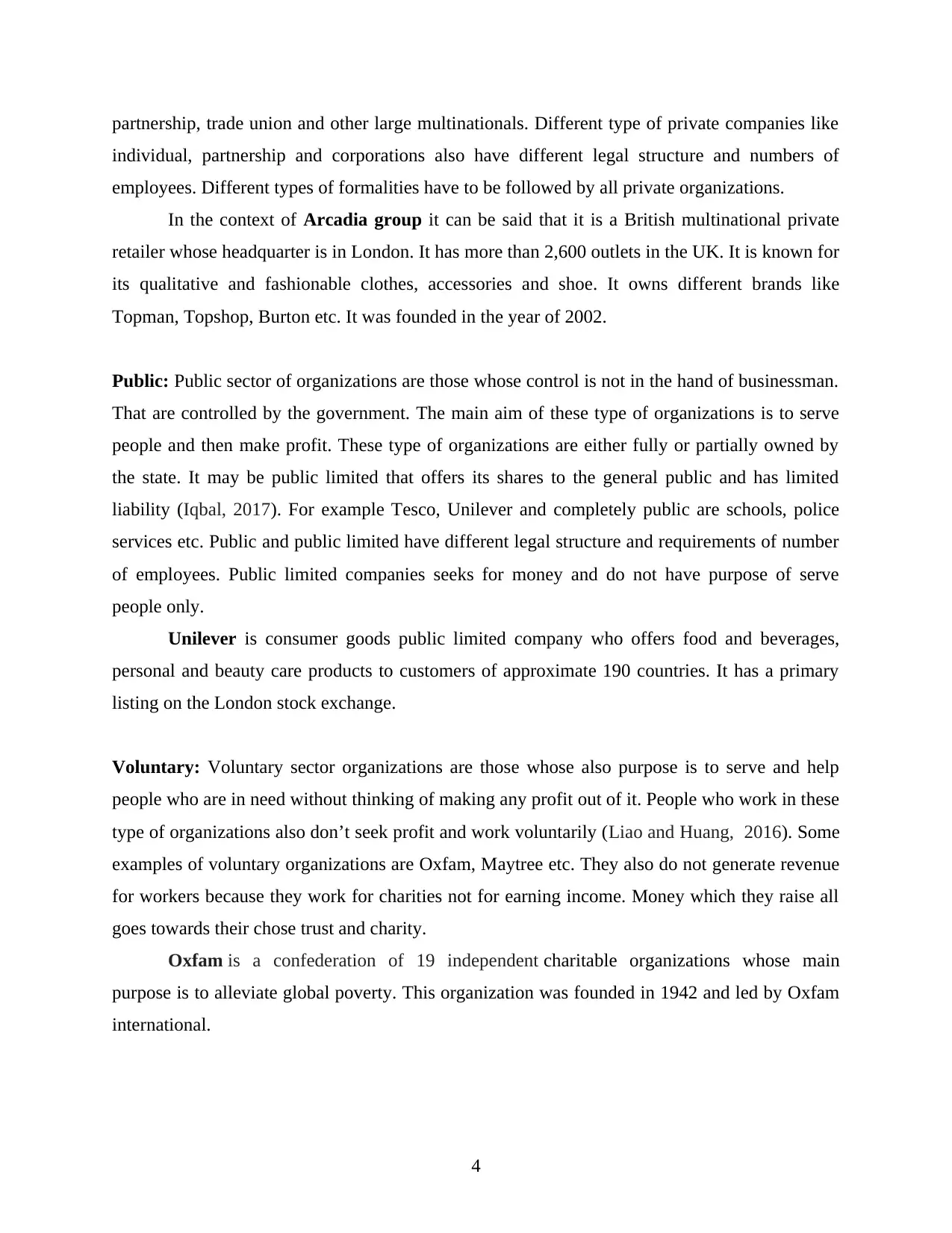
partnership, trade union and other large multinationals. Different type of private companies like
individual, partnership and corporations also have different legal structure and numbers of
employees. Different types of formalities have to be followed by all private organizations.
In the context of Arcadia group it can be said that it is a British multinational private
retailer whose headquarter is in London. It has more than 2,600 outlets in the UK. It is known for
its qualitative and fashionable clothes, accessories and shoe. It owns different brands like
Topman, Topshop, Burton etc. It was founded in the year of 2002.
Public: Public sector of organizations are those whose control is not in the hand of businessman.
That are controlled by the government. The main aim of these type of organizations is to serve
people and then make profit. These type of organizations are either fully or partially owned by
the state. It may be public limited that offers its shares to the general public and has limited
liability (Iqbal, 2017). For example Tesco, Unilever and completely public are schools, police
services etc. Public and public limited have different legal structure and requirements of number
of employees. Public limited companies seeks for money and do not have purpose of serve
people only.
Unilever is consumer goods public limited company who offers food and beverages,
personal and beauty care products to customers of approximate 190 countries. It has a primary
listing on the London stock exchange.
Voluntary: Voluntary sector organizations are those whose also purpose is to serve and help
people who are in need without thinking of making any profit out of it. People who work in these
type of organizations also don’t seek profit and work voluntarily (Liao and Huang, 2016). Some
examples of voluntary organizations are Oxfam, Maytree etc. They also do not generate revenue
for workers because they work for charities not for earning income. Money which they raise all
goes towards their chose trust and charity.
Oxfam is a confederation of 19 independent charitable organizations whose main
purpose is to alleviate global poverty. This organization was founded in 1942 and led by Oxfam
international.
4
individual, partnership and corporations also have different legal structure and numbers of
employees. Different types of formalities have to be followed by all private organizations.
In the context of Arcadia group it can be said that it is a British multinational private
retailer whose headquarter is in London. It has more than 2,600 outlets in the UK. It is known for
its qualitative and fashionable clothes, accessories and shoe. It owns different brands like
Topman, Topshop, Burton etc. It was founded in the year of 2002.
Public: Public sector of organizations are those whose control is not in the hand of businessman.
That are controlled by the government. The main aim of these type of organizations is to serve
people and then make profit. These type of organizations are either fully or partially owned by
the state. It may be public limited that offers its shares to the general public and has limited
liability (Iqbal, 2017). For example Tesco, Unilever and completely public are schools, police
services etc. Public and public limited have different legal structure and requirements of number
of employees. Public limited companies seeks for money and do not have purpose of serve
people only.
Unilever is consumer goods public limited company who offers food and beverages,
personal and beauty care products to customers of approximate 190 countries. It has a primary
listing on the London stock exchange.
Voluntary: Voluntary sector organizations are those whose also purpose is to serve and help
people who are in need without thinking of making any profit out of it. People who work in these
type of organizations also don’t seek profit and work voluntarily (Liao and Huang, 2016). Some
examples of voluntary organizations are Oxfam, Maytree etc. They also do not generate revenue
for workers because they work for charities not for earning income. Money which they raise all
goes towards their chose trust and charity.
Oxfam is a confederation of 19 independent charitable organizations whose main
purpose is to alleviate global poverty. This organization was founded in 1942 and led by Oxfam
international.
4
Secure Best Marks with AI Grader
Need help grading? Try our AI Grader for instant feedback on your assignments.
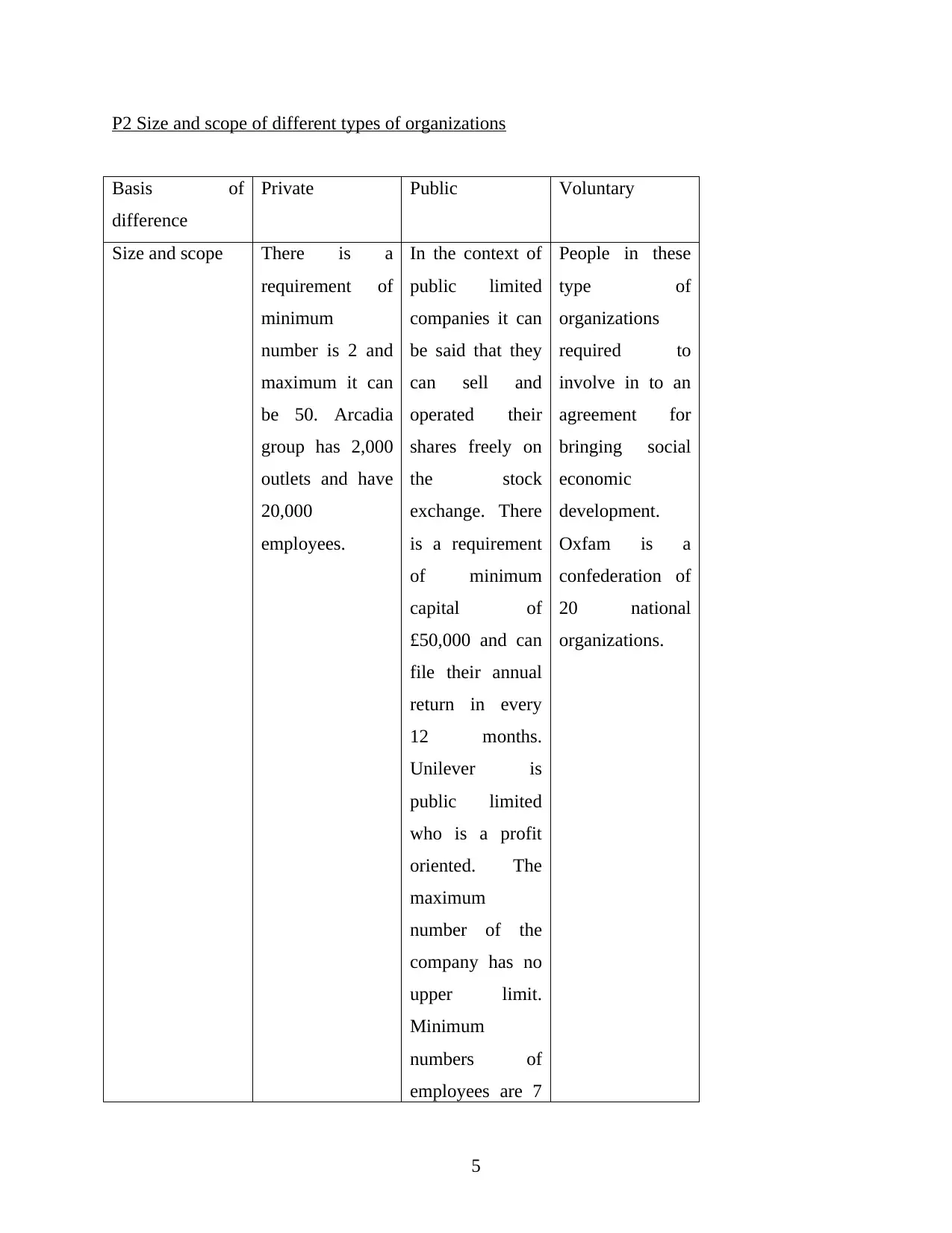
P2 Size and scope of different types of organizations
Basis of
difference
Private Public Voluntary
Size and scope There is a
requirement of
minimum
number is 2 and
maximum it can
be 50. Arcadia
group has 2,000
outlets and have
20,000
employees.
In the context of
public limited
companies it can
be said that they
can sell and
operated their
shares freely on
the stock
exchange. There
is a requirement
of minimum
capital of
£50,000 and can
file their annual
return in every
12 months.
Unilever is
public limited
who is a profit
oriented. The
maximum
number of the
company has no
upper limit.
Minimum
numbers of
employees are 7
People in these
type of
organizations
required to
involve in to an
agreement for
bringing social
economic
development.
Oxfam is a
confederation of
20 national
organizations.
5
Basis of
difference
Private Public Voluntary
Size and scope There is a
requirement of
minimum
number is 2 and
maximum it can
be 50. Arcadia
group has 2,000
outlets and have
20,000
employees.
In the context of
public limited
companies it can
be said that they
can sell and
operated their
shares freely on
the stock
exchange. There
is a requirement
of minimum
capital of
£50,000 and can
file their annual
return in every
12 months.
Unilever is
public limited
who is a profit
oriented. The
maximum
number of the
company has no
upper limit.
Minimum
numbers of
employees are 7
People in these
type of
organizations
required to
involve in to an
agreement for
bringing social
economic
development.
Oxfam is a
confederation of
20 national
organizations.
5
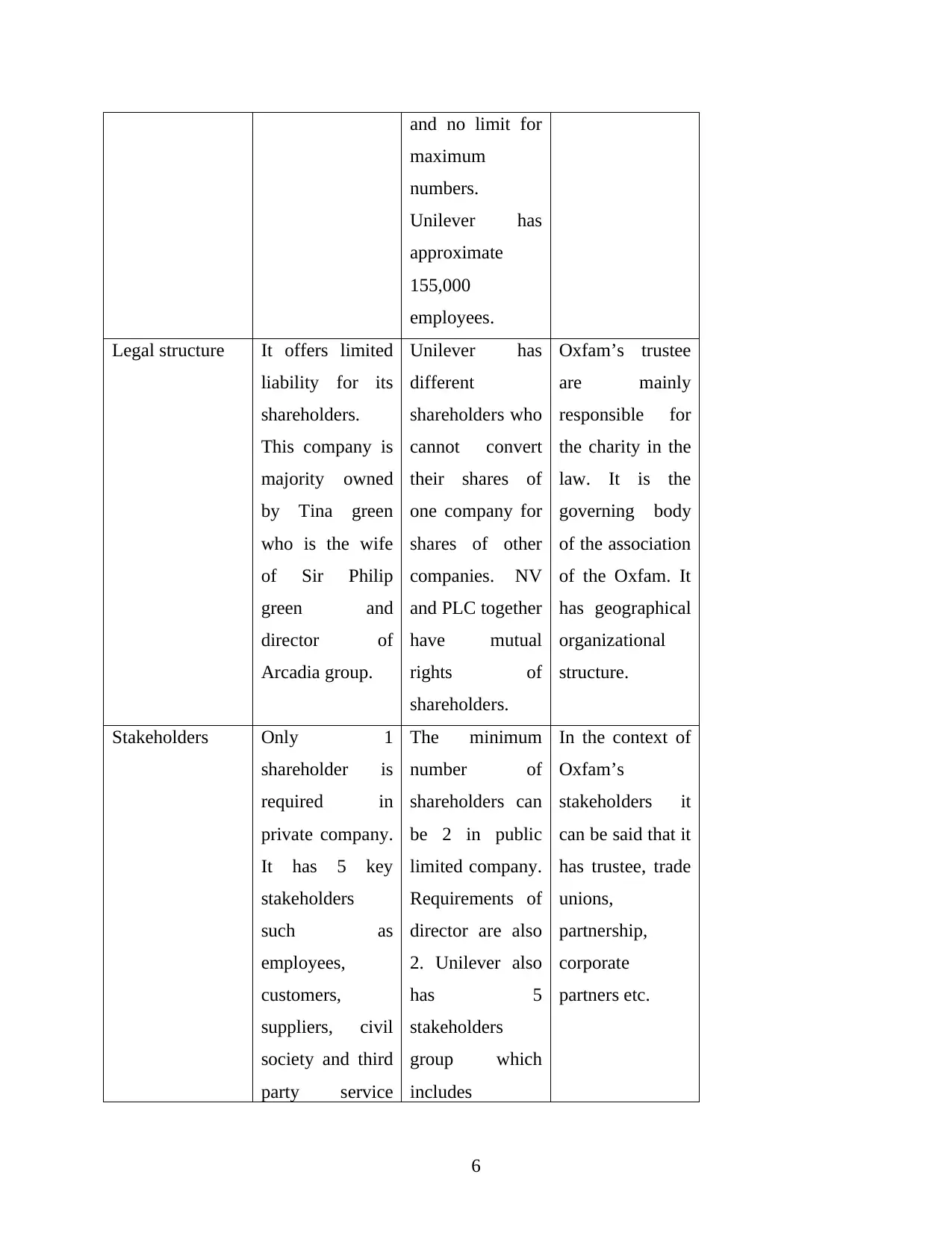
and no limit for
maximum
numbers.
Unilever has
approximate
155,000
employees.
Legal structure It offers limited
liability for its
shareholders.
This company is
majority owned
by Tina green
who is the wife
of Sir Philip
green and
director of
Arcadia group.
Unilever has
different
shareholders who
cannot convert
their shares of
one company for
shares of other
companies. NV
and PLC together
have mutual
rights of
shareholders.
Oxfam’s trustee
are mainly
responsible for
the charity in the
law. It is the
governing body
of the association
of the Oxfam. It
has geographical
organizational
structure.
Stakeholders Only 1
shareholder is
required in
private company.
It has 5 key
stakeholders
such as
employees,
customers,
suppliers, civil
society and third
party service
The minimum
number of
shareholders can
be 2 in public
limited company.
Requirements of
director are also
2. Unilever also
has 5
stakeholders
group which
includes
In the context of
Oxfam’s
stakeholders it
can be said that it
has trustee, trade
unions,
partnership,
corporate
partners etc.
6
maximum
numbers.
Unilever has
approximate
155,000
employees.
Legal structure It offers limited
liability for its
shareholders.
This company is
majority owned
by Tina green
who is the wife
of Sir Philip
green and
director of
Arcadia group.
Unilever has
different
shareholders who
cannot convert
their shares of
one company for
shares of other
companies. NV
and PLC together
have mutual
rights of
shareholders.
Oxfam’s trustee
are mainly
responsible for
the charity in the
law. It is the
governing body
of the association
of the Oxfam. It
has geographical
organizational
structure.
Stakeholders Only 1
shareholder is
required in
private company.
It has 5 key
stakeholders
such as
employees,
customers,
suppliers, civil
society and third
party service
The minimum
number of
shareholders can
be 2 in public
limited company.
Requirements of
director are also
2. Unilever also
has 5
stakeholders
group which
includes
In the context of
Oxfam’s
stakeholders it
can be said that it
has trustee, trade
unions,
partnership,
corporate
partners etc.
6
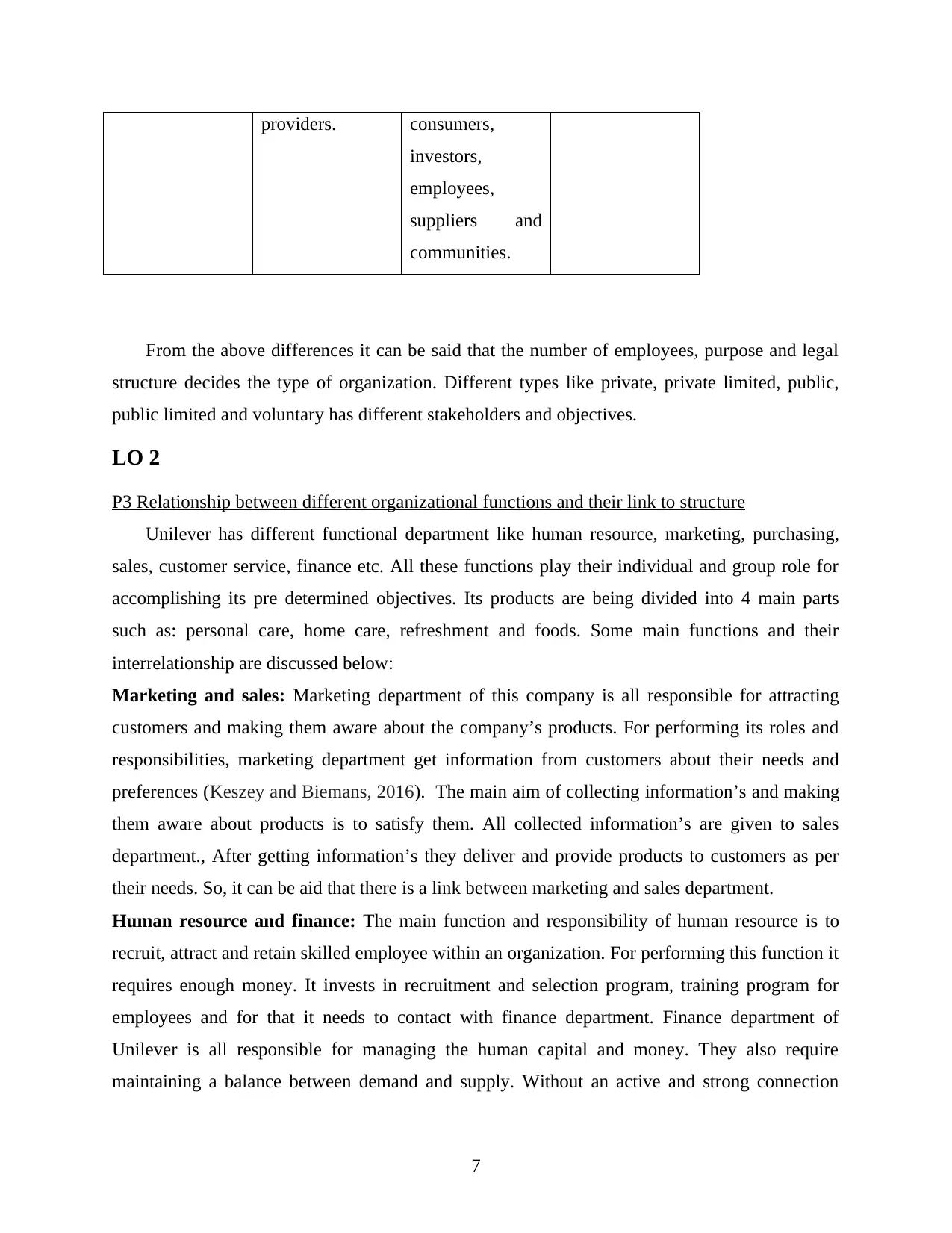
providers. consumers,
investors,
employees,
suppliers and
communities.
From the above differences it can be said that the number of employees, purpose and legal
structure decides the type of organization. Different types like private, private limited, public,
public limited and voluntary has different stakeholders and objectives.
LO 2
P3 Relationship between different organizational functions and their link to structure
Unilever has different functional department like human resource, marketing, purchasing,
sales, customer service, finance etc. All these functions play their individual and group role for
accomplishing its pre determined objectives. Its products are being divided into 4 main parts
such as: personal care, home care, refreshment and foods. Some main functions and their
interrelationship are discussed below:
Marketing and sales: Marketing department of this company is all responsible for attracting
customers and making them aware about the company’s products. For performing its roles and
responsibilities, marketing department get information from customers about their needs and
preferences (Keszey and Biemans, 2016). The main aim of collecting information’s and making
them aware about products is to satisfy them. All collected information’s are given to sales
department., After getting information’s they deliver and provide products to customers as per
their needs. So, it can be aid that there is a link between marketing and sales department.
Human resource and finance: The main function and responsibility of human resource is to
recruit, attract and retain skilled employee within an organization. For performing this function it
requires enough money. It invests in recruitment and selection program, training program for
employees and for that it needs to contact with finance department. Finance department of
Unilever is all responsible for managing the human capital and money. They also require
maintaining a balance between demand and supply. Without an active and strong connection
7
investors,
employees,
suppliers and
communities.
From the above differences it can be said that the number of employees, purpose and legal
structure decides the type of organization. Different types like private, private limited, public,
public limited and voluntary has different stakeholders and objectives.
LO 2
P3 Relationship between different organizational functions and their link to structure
Unilever has different functional department like human resource, marketing, purchasing,
sales, customer service, finance etc. All these functions play their individual and group role for
accomplishing its pre determined objectives. Its products are being divided into 4 main parts
such as: personal care, home care, refreshment and foods. Some main functions and their
interrelationship are discussed below:
Marketing and sales: Marketing department of this company is all responsible for attracting
customers and making them aware about the company’s products. For performing its roles and
responsibilities, marketing department get information from customers about their needs and
preferences (Keszey and Biemans, 2016). The main aim of collecting information’s and making
them aware about products is to satisfy them. All collected information’s are given to sales
department., After getting information’s they deliver and provide products to customers as per
their needs. So, it can be aid that there is a link between marketing and sales department.
Human resource and finance: The main function and responsibility of human resource is to
recruit, attract and retain skilled employee within an organization. For performing this function it
requires enough money. It invests in recruitment and selection program, training program for
employees and for that it needs to contact with finance department. Finance department of
Unilever is all responsible for managing the human capital and money. They also require
maintaining a balance between demand and supply. Without an active and strong connection
7
Paraphrase This Document
Need a fresh take? Get an instant paraphrase of this document with our AI Paraphraser

with finance, human resource department cannot perform its all functioning an effective manner.
So this relationship also shows that interrelationship between different functional departments
can help Unilever in achieving its goals (Francescato and Aber, 2015).
Organizational structure: In the context of organizational structure, it is stated that this
company use corporate and hierarchical structure. It also believes that this structure give it
suitable balance between corporate governance and its flexibility. Each stage and level of its
hierarchical structure serves different functions which have 2 executive directors. The main aim
of using this structure is to make its products innovative and able to all functions to work as a
team (Ismail, A. and et.al., 2015). There are some other features of its organizational corporate
structure such as: corporate executive team, geographical divisions and products type division.
Corporate executive team of this structures is divided according to its 4 products diversion.
Figure 1: Organizational culture
So, it can be said that relationship of all functional departments of Unilever have a great
impacts on its corporate structure. Relationship of departments makes it more able to develop its
structure and accomplishing its objectives.
8
So this relationship also shows that interrelationship between different functional departments
can help Unilever in achieving its goals (Francescato and Aber, 2015).
Organizational structure: In the context of organizational structure, it is stated that this
company use corporate and hierarchical structure. It also believes that this structure give it
suitable balance between corporate governance and its flexibility. Each stage and level of its
hierarchical structure serves different functions which have 2 executive directors. The main aim
of using this structure is to make its products innovative and able to all functions to work as a
team (Ismail, A. and et.al., 2015). There are some other features of its organizational corporate
structure such as: corporate executive team, geographical divisions and products type division.
Corporate executive team of this structures is divided according to its 4 products diversion.
Figure 1: Organizational culture
So, it can be said that relationship of all functional departments of Unilever have a great
impacts on its corporate structure. Relationship of departments makes it more able to develop its
structure and accomplishing its objectives.
8
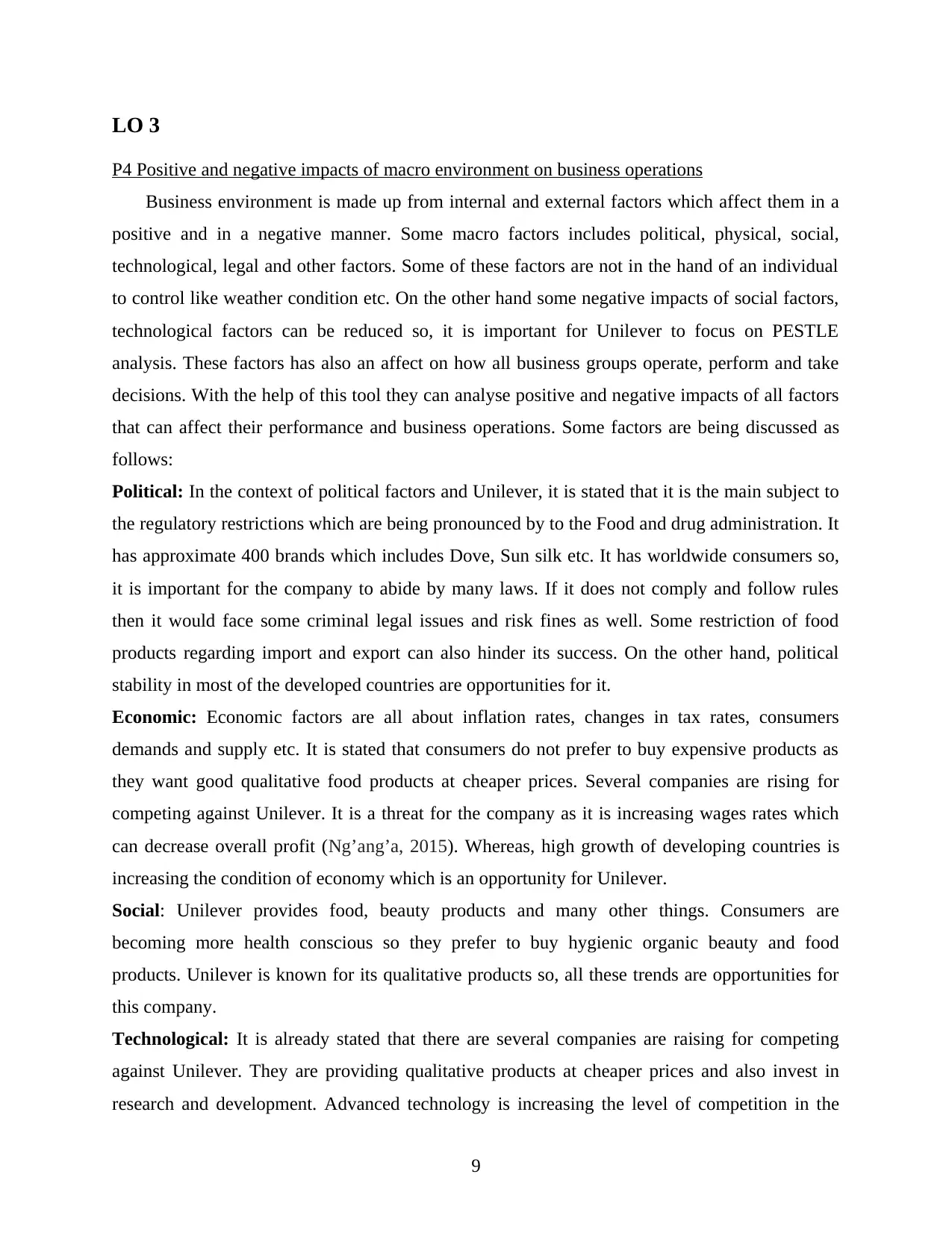
LO 3
P4 Positive and negative impacts of macro environment on business operations
Business environment is made up from internal and external factors which affect them in a
positive and in a negative manner. Some macro factors includes political, physical, social,
technological, legal and other factors. Some of these factors are not in the hand of an individual
to control like weather condition etc. On the other hand some negative impacts of social factors,
technological factors can be reduced so, it is important for Unilever to focus on PESTLE
analysis. These factors has also an affect on how all business groups operate, perform and take
decisions. With the help of this tool they can analyse positive and negative impacts of all factors
that can affect their performance and business operations. Some factors are being discussed as
follows:
Political: In the context of political factors and Unilever, it is stated that it is the main subject to
the regulatory restrictions which are being pronounced by to the Food and drug administration. It
has approximate 400 brands which includes Dove, Sun silk etc. It has worldwide consumers so,
it is important for the company to abide by many laws. If it does not comply and follow rules
then it would face some criminal legal issues and risk fines as well. Some restriction of food
products regarding import and export can also hinder its success. On the other hand, political
stability in most of the developed countries are opportunities for it.
Economic: Economic factors are all about inflation rates, changes in tax rates, consumers
demands and supply etc. It is stated that consumers do not prefer to buy expensive products as
they want good qualitative food products at cheaper prices. Several companies are rising for
competing against Unilever. It is a threat for the company as it is increasing wages rates which
can decrease overall profit (Ng’ang’a, 2015). Whereas, high growth of developing countries is
increasing the condition of economy which is an opportunity for Unilever.
Social: Unilever provides food, beauty products and many other things. Consumers are
becoming more health conscious so they prefer to buy hygienic organic beauty and food
products. Unilever is known for its qualitative products so, all these trends are opportunities for
this company.
Technological: It is already stated that there are several companies are raising for competing
against Unilever. They are providing qualitative products at cheaper prices and also invest in
research and development. Advanced technology is increasing the level of competition in the
9
P4 Positive and negative impacts of macro environment on business operations
Business environment is made up from internal and external factors which affect them in a
positive and in a negative manner. Some macro factors includes political, physical, social,
technological, legal and other factors. Some of these factors are not in the hand of an individual
to control like weather condition etc. On the other hand some negative impacts of social factors,
technological factors can be reduced so, it is important for Unilever to focus on PESTLE
analysis. These factors has also an affect on how all business groups operate, perform and take
decisions. With the help of this tool they can analyse positive and negative impacts of all factors
that can affect their performance and business operations. Some factors are being discussed as
follows:
Political: In the context of political factors and Unilever, it is stated that it is the main subject to
the regulatory restrictions which are being pronounced by to the Food and drug administration. It
has approximate 400 brands which includes Dove, Sun silk etc. It has worldwide consumers so,
it is important for the company to abide by many laws. If it does not comply and follow rules
then it would face some criminal legal issues and risk fines as well. Some restriction of food
products regarding import and export can also hinder its success. On the other hand, political
stability in most of the developed countries are opportunities for it.
Economic: Economic factors are all about inflation rates, changes in tax rates, consumers
demands and supply etc. It is stated that consumers do not prefer to buy expensive products as
they want good qualitative food products at cheaper prices. Several companies are rising for
competing against Unilever. It is a threat for the company as it is increasing wages rates which
can decrease overall profit (Ng’ang’a, 2015). Whereas, high growth of developing countries is
increasing the condition of economy which is an opportunity for Unilever.
Social: Unilever provides food, beauty products and many other things. Consumers are
becoming more health conscious so they prefer to buy hygienic organic beauty and food
products. Unilever is known for its qualitative products so, all these trends are opportunities for
this company.
Technological: It is already stated that there are several companies are raising for competing
against Unilever. They are providing qualitative products at cheaper prices and also invest in
research and development. Advanced technology is increasing the level of competition in the
9
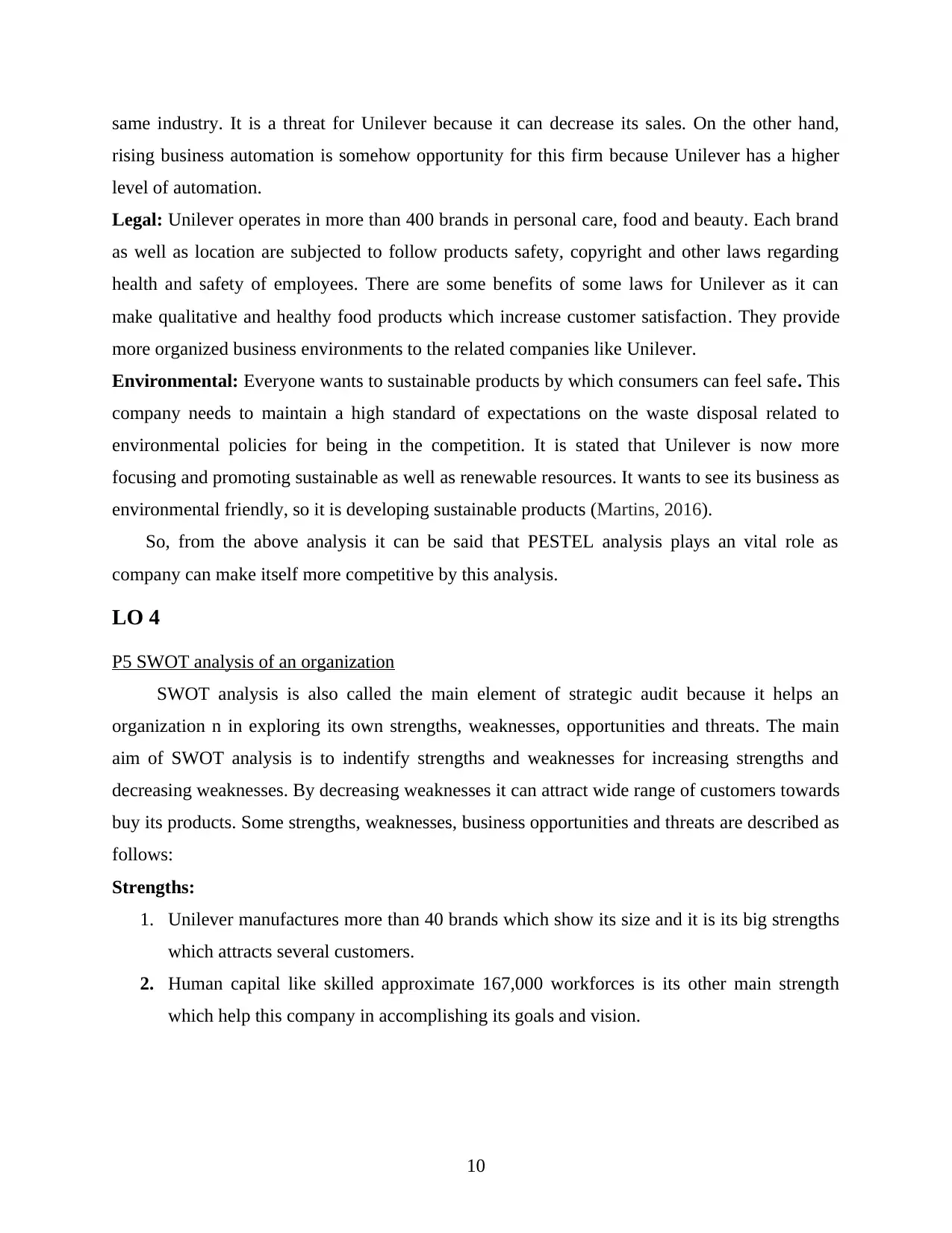
same industry. It is a threat for Unilever because it can decrease its sales. On the other hand,
rising business automation is somehow opportunity for this firm because Unilever has a higher
level of automation.
Legal: Unilever operates in more than 400 brands in personal care, food and beauty. Each brand
as well as location are subjected to follow products safety, copyright and other laws regarding
health and safety of employees. There are some benefits of some laws for Unilever as it can
make qualitative and healthy food products which increase customer satisfaction. They provide
more organized business environments to the related companies like Unilever.
Environmental: Everyone wants to sustainable products by which consumers can feel safe. This
company needs to maintain a high standard of expectations on the waste disposal related to
environmental policies for being in the competition. It is stated that Unilever is now more
focusing and promoting sustainable as well as renewable resources. It wants to see its business as
environmental friendly, so it is developing sustainable products (Martins, 2016).
So, from the above analysis it can be said that PESTEL analysis plays an vital role as
company can make itself more competitive by this analysis.
LO 4
P5 SWOT analysis of an organization
SWOT analysis is also called the main element of strategic audit because it helps an
organization n in exploring its own strengths, weaknesses, opportunities and threats. The main
aim of SWOT analysis is to indentify strengths and weaknesses for increasing strengths and
decreasing weaknesses. By decreasing weaknesses it can attract wide range of customers towards
buy its products. Some strengths, weaknesses, business opportunities and threats are described as
follows:
Strengths:
1. Unilever manufactures more than 40 brands which show its size and it is its big strengths
which attracts several customers.
2. Human capital like skilled approximate 167,000 workforces is its other main strength
which help this company in accomplishing its goals and vision.
10
rising business automation is somehow opportunity for this firm because Unilever has a higher
level of automation.
Legal: Unilever operates in more than 400 brands in personal care, food and beauty. Each brand
as well as location are subjected to follow products safety, copyright and other laws regarding
health and safety of employees. There are some benefits of some laws for Unilever as it can
make qualitative and healthy food products which increase customer satisfaction. They provide
more organized business environments to the related companies like Unilever.
Environmental: Everyone wants to sustainable products by which consumers can feel safe. This
company needs to maintain a high standard of expectations on the waste disposal related to
environmental policies for being in the competition. It is stated that Unilever is now more
focusing and promoting sustainable as well as renewable resources. It wants to see its business as
environmental friendly, so it is developing sustainable products (Martins, 2016).
So, from the above analysis it can be said that PESTEL analysis plays an vital role as
company can make itself more competitive by this analysis.
LO 4
P5 SWOT analysis of an organization
SWOT analysis is also called the main element of strategic audit because it helps an
organization n in exploring its own strengths, weaknesses, opportunities and threats. The main
aim of SWOT analysis is to indentify strengths and weaknesses for increasing strengths and
decreasing weaknesses. By decreasing weaknesses it can attract wide range of customers towards
buy its products. Some strengths, weaknesses, business opportunities and threats are described as
follows:
Strengths:
1. Unilever manufactures more than 40 brands which show its size and it is its big strengths
which attracts several customers.
2. Human capital like skilled approximate 167,000 workforces is its other main strength
which help this company in accomplishing its goals and vision.
10
Secure Best Marks with AI Grader
Need help grading? Try our AI Grader for instant feedback on your assignments.
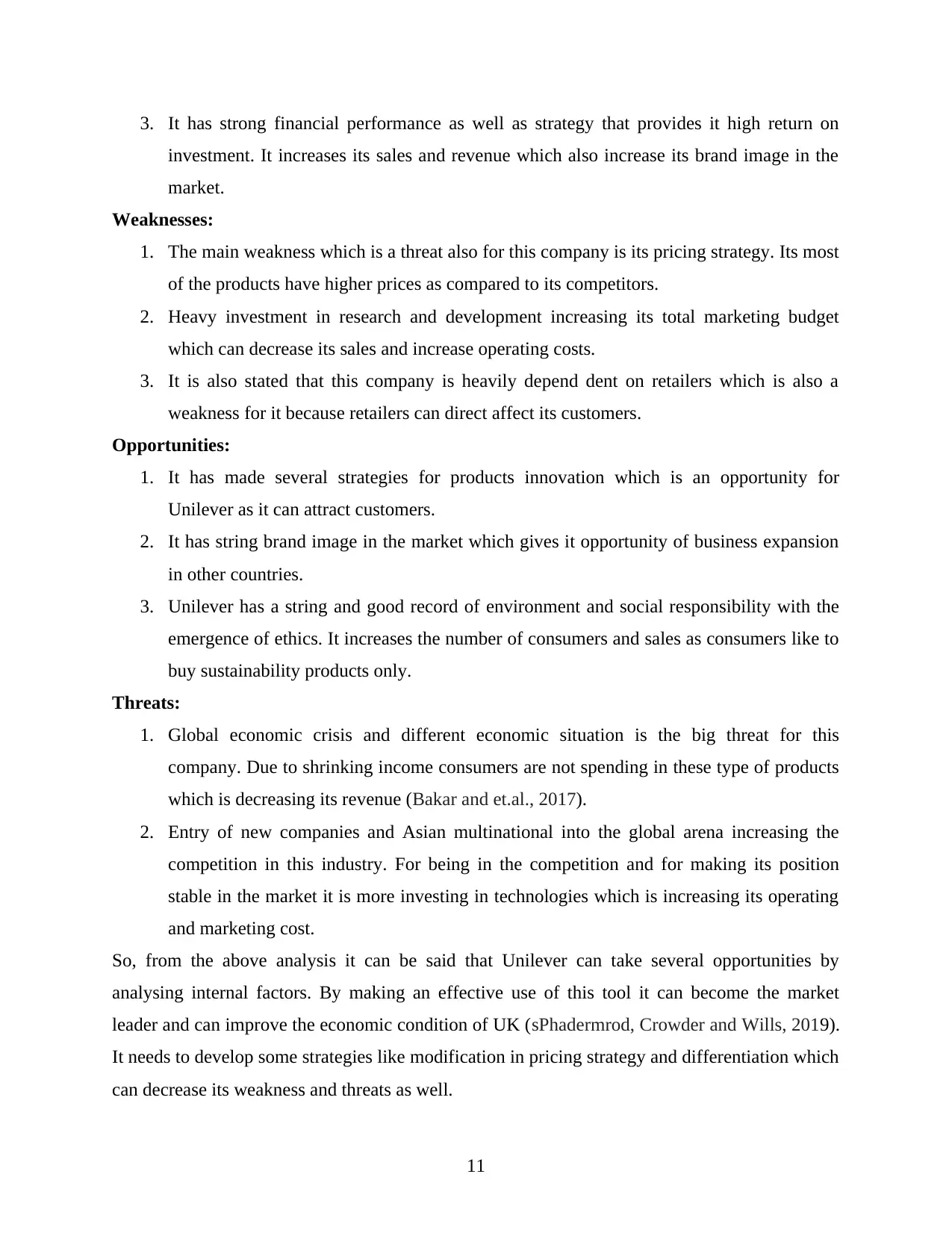
3. It has strong financial performance as well as strategy that provides it high return on
investment. It increases its sales and revenue which also increase its brand image in the
market.
Weaknesses:
1. The main weakness which is a threat also for this company is its pricing strategy. Its most
of the products have higher prices as compared to its competitors.
2. Heavy investment in research and development increasing its total marketing budget
which can decrease its sales and increase operating costs.
3. It is also stated that this company is heavily depend dent on retailers which is also a
weakness for it because retailers can direct affect its customers.
Opportunities:
1. It has made several strategies for products innovation which is an opportunity for
Unilever as it can attract customers.
2. It has string brand image in the market which gives it opportunity of business expansion
in other countries.
3. Unilever has a string and good record of environment and social responsibility with the
emergence of ethics. It increases the number of consumers and sales as consumers like to
buy sustainability products only.
Threats:
1. Global economic crisis and different economic situation is the big threat for this
company. Due to shrinking income consumers are not spending in these type of products
which is decreasing its revenue (Bakar and et.al., 2017).
2. Entry of new companies and Asian multinational into the global arena increasing the
competition in this industry. For being in the competition and for making its position
stable in the market it is more investing in technologies which is increasing its operating
and marketing cost.
So, from the above analysis it can be said that Unilever can take several opportunities by
analysing internal factors. By making an effective use of this tool it can become the market
leader and can improve the economic condition of UK (sPhadermrod, Crowder and Wills, 2019).
It needs to develop some strategies like modification in pricing strategy and differentiation which
can decrease its weakness and threats as well.
11
investment. It increases its sales and revenue which also increase its brand image in the
market.
Weaknesses:
1. The main weakness which is a threat also for this company is its pricing strategy. Its most
of the products have higher prices as compared to its competitors.
2. Heavy investment in research and development increasing its total marketing budget
which can decrease its sales and increase operating costs.
3. It is also stated that this company is heavily depend dent on retailers which is also a
weakness for it because retailers can direct affect its customers.
Opportunities:
1. It has made several strategies for products innovation which is an opportunity for
Unilever as it can attract customers.
2. It has string brand image in the market which gives it opportunity of business expansion
in other countries.
3. Unilever has a string and good record of environment and social responsibility with the
emergence of ethics. It increases the number of consumers and sales as consumers like to
buy sustainability products only.
Threats:
1. Global economic crisis and different economic situation is the big threat for this
company. Due to shrinking income consumers are not spending in these type of products
which is decreasing its revenue (Bakar and et.al., 2017).
2. Entry of new companies and Asian multinational into the global arena increasing the
competition in this industry. For being in the competition and for making its position
stable in the market it is more investing in technologies which is increasing its operating
and marketing cost.
So, from the above analysis it can be said that Unilever can take several opportunities by
analysing internal factors. By making an effective use of this tool it can become the market
leader and can improve the economic condition of UK (sPhadermrod, Crowder and Wills, 2019).
It needs to develop some strategies like modification in pricing strategy and differentiation which
can decrease its weakness and threats as well.
11
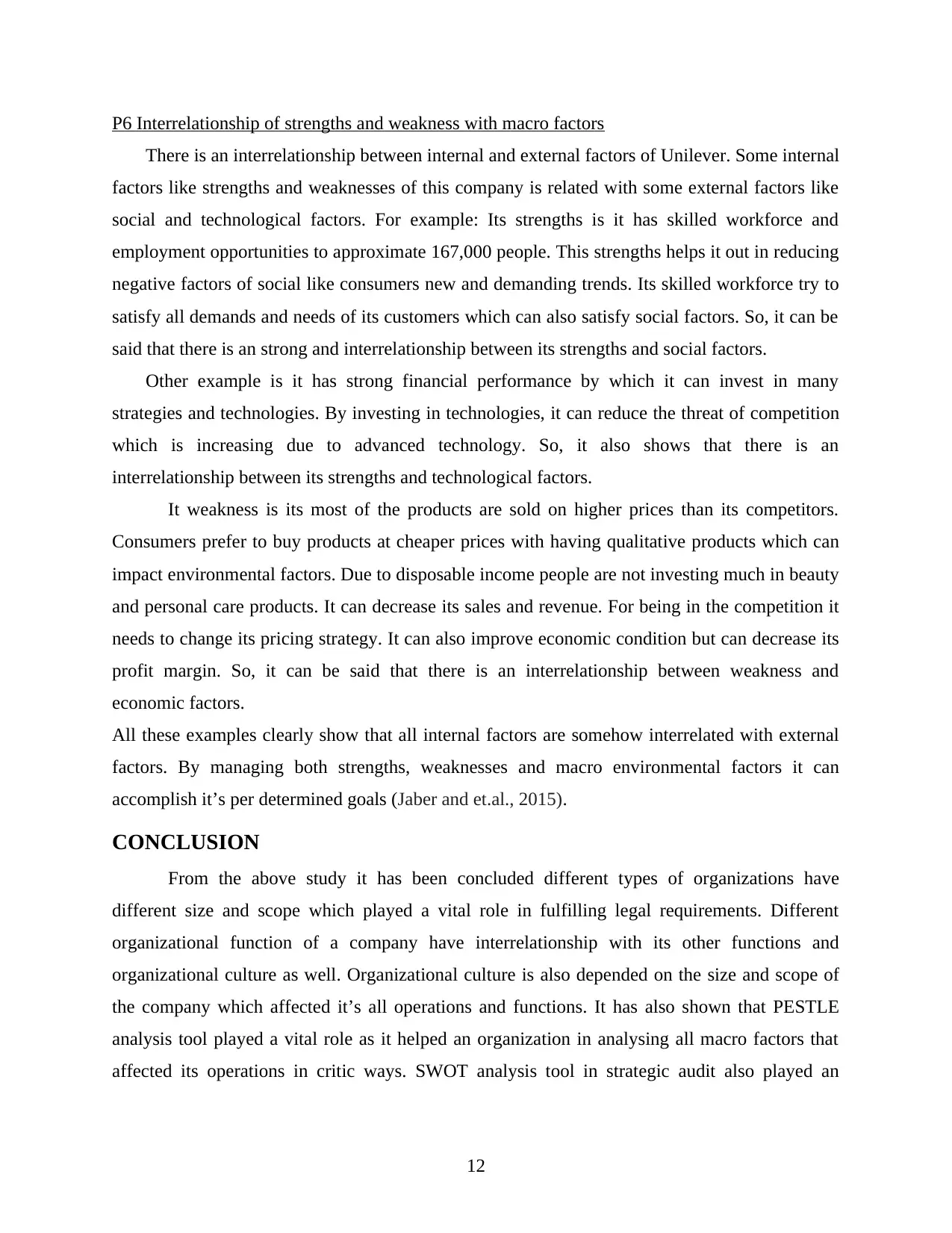
P6 Interrelationship of strengths and weakness with macro factors
There is an interrelationship between internal and external factors of Unilever. Some internal
factors like strengths and weaknesses of this company is related with some external factors like
social and technological factors. For example: Its strengths is it has skilled workforce and
employment opportunities to approximate 167,000 people. This strengths helps it out in reducing
negative factors of social like consumers new and demanding trends. Its skilled workforce try to
satisfy all demands and needs of its customers which can also satisfy social factors. So, it can be
said that there is an strong and interrelationship between its strengths and social factors.
Other example is it has strong financial performance by which it can invest in many
strategies and technologies. By investing in technologies, it can reduce the threat of competition
which is increasing due to advanced technology. So, it also shows that there is an
interrelationship between its strengths and technological factors.
It weakness is its most of the products are sold on higher prices than its competitors.
Consumers prefer to buy products at cheaper prices with having qualitative products which can
impact environmental factors. Due to disposable income people are not investing much in beauty
and personal care products. It can decrease its sales and revenue. For being in the competition it
needs to change its pricing strategy. It can also improve economic condition but can decrease its
profit margin. So, it can be said that there is an interrelationship between weakness and
economic factors.
All these examples clearly show that all internal factors are somehow interrelated with external
factors. By managing both strengths, weaknesses and macro environmental factors it can
accomplish it’s per determined goals (Jaber and et.al., 2015).
CONCLUSION
From the above study it has been concluded different types of organizations have
different size and scope which played a vital role in fulfilling legal requirements. Different
organizational function of a company have interrelationship with its other functions and
organizational culture as well. Organizational culture is also depended on the size and scope of
the company which affected it’s all operations and functions. It has also shown that PESTLE
analysis tool played a vital role as it helped an organization in analysing all macro factors that
affected its operations in critic ways. SWOT analysis tool in strategic audit also played an
12
There is an interrelationship between internal and external factors of Unilever. Some internal
factors like strengths and weaknesses of this company is related with some external factors like
social and technological factors. For example: Its strengths is it has skilled workforce and
employment opportunities to approximate 167,000 people. This strengths helps it out in reducing
negative factors of social like consumers new and demanding trends. Its skilled workforce try to
satisfy all demands and needs of its customers which can also satisfy social factors. So, it can be
said that there is an strong and interrelationship between its strengths and social factors.
Other example is it has strong financial performance by which it can invest in many
strategies and technologies. By investing in technologies, it can reduce the threat of competition
which is increasing due to advanced technology. So, it also shows that there is an
interrelationship between its strengths and technological factors.
It weakness is its most of the products are sold on higher prices than its competitors.
Consumers prefer to buy products at cheaper prices with having qualitative products which can
impact environmental factors. Due to disposable income people are not investing much in beauty
and personal care products. It can decrease its sales and revenue. For being in the competition it
needs to change its pricing strategy. It can also improve economic condition but can decrease its
profit margin. So, it can be said that there is an interrelationship between weakness and
economic factors.
All these examples clearly show that all internal factors are somehow interrelated with external
factors. By managing both strengths, weaknesses and macro environmental factors it can
accomplish it’s per determined goals (Jaber and et.al., 2015).
CONCLUSION
From the above study it has been concluded different types of organizations have
different size and scope which played a vital role in fulfilling legal requirements. Different
organizational function of a company have interrelationship with its other functions and
organizational culture as well. Organizational culture is also depended on the size and scope of
the company which affected it’s all operations and functions. It has also shown that PESTLE
analysis tool played a vital role as it helped an organization in analysing all macro factors that
affected its operations in critic ways. SWOT analysis tool in strategic audit also played an
12
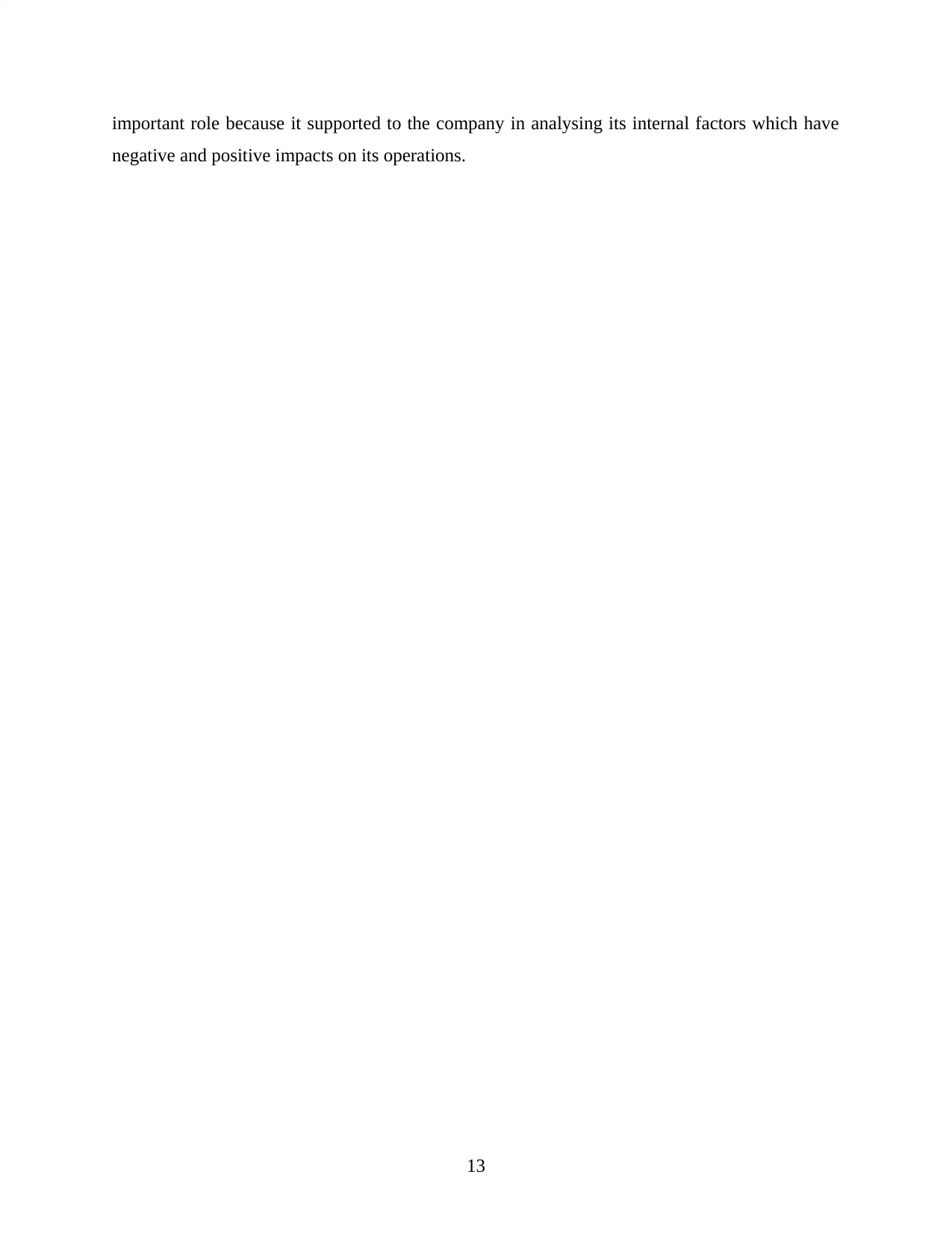
important role because it supported to the company in analysing its internal factors which have
negative and positive impacts on its operations.
13
negative and positive impacts on its operations.
13
1 out of 13
Related Documents
Your All-in-One AI-Powered Toolkit for Academic Success.
+13062052269
info@desklib.com
Available 24*7 on WhatsApp / Email
![[object Object]](/_next/static/media/star-bottom.7253800d.svg)
Unlock your academic potential
© 2024 | Zucol Services PVT LTD | All rights reserved.





